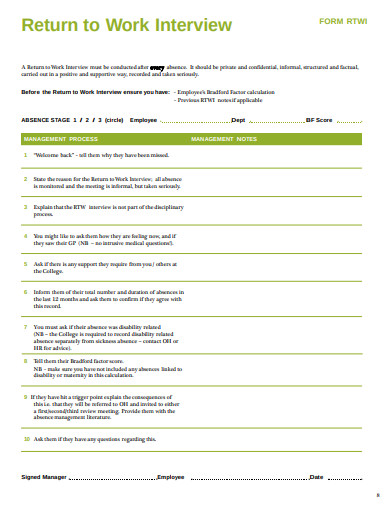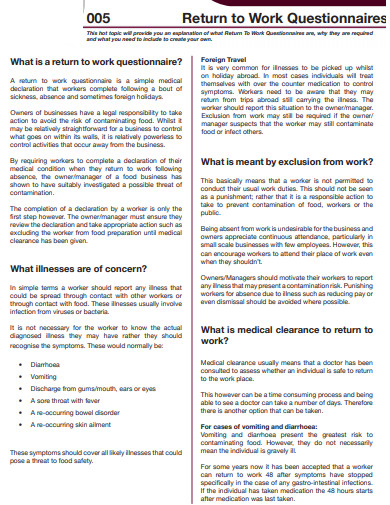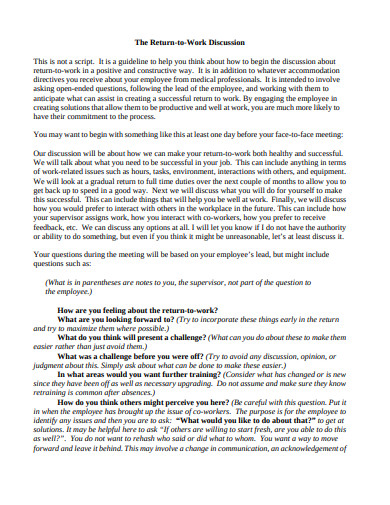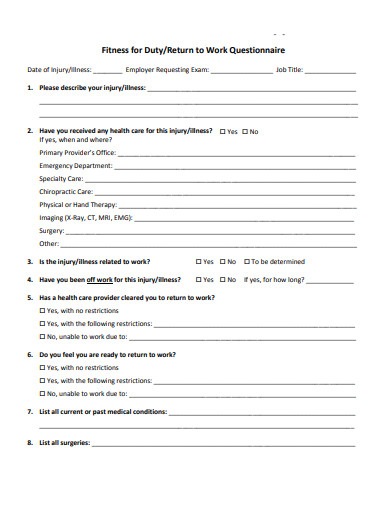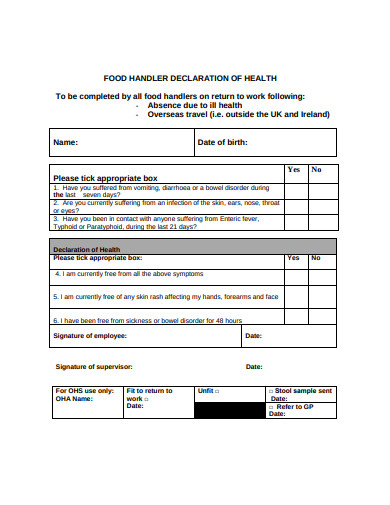5 Return to Work Questionnaire Examples
Employee A called your office saying she is sick and could not report to work. You could hear her cough and blow her nose in between sentences. Naturally, you wished her well. During your lunch break, you saw in her Instagram story that she was out partying with friends that same Tuesday afternoon. Knowing your company’s policy on this situation, what human resource strategy will you use to come about this situation when A will return to work? And how can you deter dishonest sick leave reasons like this in the future?
Return to work interviews allows the management to look at how the employees are faring in the work environment, and to evaluate if the company can remedy problems. During the meeting with the HR personnel, the returning employee fills in a questionnaire before both persons talk about the latter’s absence. It isn’t a form of intimidation, as some people are afraid of. Rather, the human resource manager assesses the worker if he or she is fit to reintegrate into the system. If the person called in sick, the HR manager checks if the employee has fully recovered.
The process also reduces the likelihood of a person abusing his or her sick leave. The manager checks for consistency with the employee’s account on why he or she called in sick. If the person was dishonest about the reason, he or she can be sanctioned accordingly. If the person’s reason is valid and sound despite lying, the company’s response is according to its own discretion. Concerning our hypothetical case of dishonesty earlier, A’s absence wouldn’t hurt the company. After all, it’s just one day. But, what if a significant percent of your employee population, unfortunately, think like this? And they wouldn’t think much of it because no one has received a reprimand: It must be okay. Your company productivity will suffer, and team relations will be strained. Inaction to such behavior can be misinterpreted as a free pass to behave in such a way.
The Trouble with Our Sick Leave Policy
This doesn’t mean that employees shouldn’t be given sick leave credits. Sick leave policy allows for a paid period when employees can put their health and safety first before work. The law requires companies and employers to honor this. Workers can use their leave credits when they are feeling unwell to report to work. To keep everyone safe, employers and employees have to acknowledge the importance of maintaining good health. Some days, we are just sick and couldn’t function effectively. Reporting to work would spread pathogens to others, harming more people in the process. But because it is easy to get away with false sick leave, some people just resort to calling in sick when they don’t have a justifiable reason to miss work.
Just Being Present Doesn’t Help
This culture of sick leave abuse leads to mistrust among employers and employees. A phenomenon called presenteeism occurs when the value of an employee comes more from just being present at work than his or her actual productivity. People cannot function well when they are sick. However, one in four of the people surveyed in the UK reported that they still go to work despite being sick. The said people traced their hesitance to call in sick from worries about their productivity and pressure from work. While absences cost the industry billions of dollars, being present at work when you’re unfit to work is also unfavorable for the employees and the company. This behavior translates to reduced productivity and higher turnover rates of employees.
Salvaging Both Causes
That’s why you should properly address this behavior by strict policing of employee attendance. Diligently track the attendance of workers and of those employees who have a pattern to called in sick, as well as their excuse. For all you know, their grandfather died twice in the past five months. To avoid rampant violations and still support the health of your employees, your company must have a comprehensive attendance policy that covers the procedures and sanctions on leave benefits. Your employees won’t be scared of calling in sick when they are sick, while deceitful sick leave will be deterred. The policy should be well elaborated in the company handbook. You and the employee can respond accordingly to allegations of abuse by referring to the document to settle disputes.
4+ Return to Work Questionnaire Examples
You can use the following return to work questionnaire samples to get you started.
1. Return to Work Interview Questionnaire Form
2. Return to Work Questionnaire Example
3. Return to Work Discussion Questionnaire
4. Return to Work Questionnaire Form
5. Food Handlers on Return to Work Questionnaire
Conducting Return To Work Interview
When you are performing the interview with an employee, be reminded of the following things.
1. Make Process Consistent
Return to work interviews should follow a format. This ensures that the procedure doesn’t stand on biased ground. The kind of questions that you ask are on a case-to-case basis, but the structure of the meeting shouldn’t favor a few persons over the others. To help you follow an objective process, take advantage of return to work questionnaires. They provide a sketch of how the interview will go. Consistency doesn’t just involve the questions you ask. The interview schedule you arranged with an employee matters as well. When you are consistent in your approach, your employees will not feel that you favor select people.
2. Innocent Until Proven Otherwise
Badgering and scaring employees will not work for you. Unless you have proof of dishonesty, treat the person as though he or she is telling the truth. Your employees have the right to refuse to disclose all the details of their absence. Don’t pressure them into telling you everything. Try to keep things casual and comfortable for your employees. You can ask them how they are doing at that time. If the employee is like our hypothetical employee A earlier, and they don’t have any return to work note from doctors, slowly bring up the matter without unnecessarily intimidating them. You can start with, “Is there anything I need to know about your absence?”
3. Confirm Meeting Details
After you have talked with your employee, review the notes or the transcript of the conversation to be sure that you both are on the same page. This will avoid misunderstanding later on. Your account of the events should match the employee’s story. This includes his or her reason for absence, the employee’s current situation, and the dates of that he or she took the leave. By comparing and checking the information you obtained, you can verify if you have the correct rundown of events as reported by the employee.
4. Keep Things Private
Whatever is the content of the conversation, assure the employee that you will keep the information confidential. It is the person’s discretion if they want the rest of the workplace to know what happened to them. You have no obligation of doing that for them. Handle sensitive information with care by making sure that no one else will have access to the data. You can draft a confidentiality agreement together with the details of the meeting. You both will affix your signatures on the document after the interview. This adds a layer of protection for the employee and you during future disputes.
By checking in with your employees if they are ready to return to work, you can facilitate adjustments and rehabilitation for them to ease back in. You can also evaluate how the workspace and management can be improved to benefit the workers. The consistent assessment of every employee, regardless of the length of absence, will discourage people who abuse their sick leave benefits. In a general sense, return to work interviews and questionnaires will help you look out for the welfare of everyone. You can keep both the company and the employees happy.



